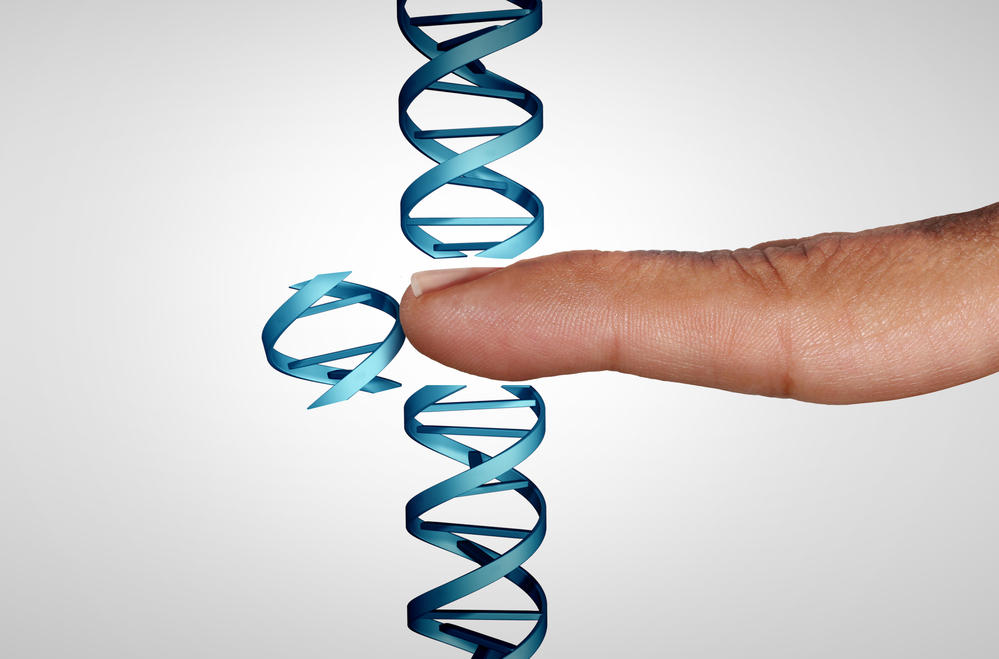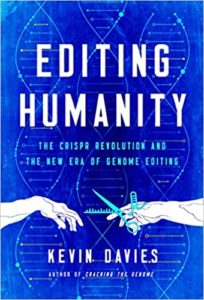

- Two scientists—French microbiologist Emmanuelle Charpentier and [Jennifer] Doudna, an American biochemist—published a groundbreaking discovery. They stood on the shoulders of many researchers around the world who had been toiling out of the public eye to understand the biological purpose of CRISPR. These Clustered Regularly Interspaced Short Palindromic Repeats (the official acronym) were known to be the critical component of a natural bacterial immune system…. Researchers in the Doudna and Charpentier labs reconfigured the molecular machinery to produce an ingenious method for precisely targeting and cutting genes and other DNA targets. Six months later, several groups, led by Feng Zhang at the Broad Institute and George Church at Harvard Medical School, showed that the DNA of mammalian cells could be edited using CRISPR.
- Kevin Davies, Editing Humanity: The CRISPR Revolution and the New Era of Genome Editing.1 Page xi.
Through a combination of foresight and luck, science journalist Kevin Davies came out with a book on CRISPR, the gene editing technique, on October 6, 2020. This turned out to be one day before the announcement that the Nobel Prize in chemistry was to be awarded to Emmanuelle Charpentier and Jennifer Doudna, whose 2012 paper ignited the CRISPR revolution.
Davies points out that “CRISPR wasn’t the result of a dedicated applied engineering effort.” (6) Instead, it emerged from a combination of accidents and increments. Researchers began with the question of how bacteria resist viruses. They found that bacteria had chemical defense mechanisms that were effective at altering DNA. From there, a number of incremental steps got scientists to the point where they could use these bacterial chemicals to intentionally alter genes in human cells, most notably a fertilized egg.
I recommend Editing Humanity for a number of reasons.
- • Davies writes in an entertaining fashion. Just as television network coverage of the Olympics draws in the audience by emphasizing the human stories of the athletes, Davies gives us human stories of the scientists while being spare with technical scientific details.
- • He explains the significance of CRISPR in terms of its potential for curing and preventing diseases in humans, enhancing agriculture, and perhaps bringing back extinct species. At the same time, he is careful to point out the scientific and regulatory barriers that still need to be addressed.
- • He spells out the issues associated with germline genetic engineering, meaning altering the DNA of a fertilized egg.
- • He makes one think about the challenge of allocating credit and adjudicating patents in the context of advanced biological research.
My essay will focus on the latter two issues.
Draw the line at the germline?
Many scientists express horror at germline editing, but one can argue that it is better than somatic gene therapy, which means attempting to edit the genes in a developed human body. Davies writes,
- … there is widespread opposition to the notion of tampering with the germline, knitting by hand a permanent sequence alteration that would be passed on to future generations. But in a practical sense, editing a human embryo is a much safer proposition than treating a child or adult. [George] Church argues that germline editing offers three intrinsic advantages. First, it is more effective than other delivery systems at reaching all cells in the body. Second, after administering the edit, every future child and descendant would receive the edit free rather than costing millions of dollars for their own somatic gene therapy. And third, germline editing goes through a single cell, whereas somatic therapies impact millions of cells… any one of which could become cancerous. (354)
Suppose that a baby could inherit two copies of a bad gene, one each from the mother and the father, resulting in a syndrome that leads to miserable life and/or early death. Of all the ways of allowing the parents to have children and avoid this problem, germline editing may prove to have the best reward/risk ratio.
Critics of germline engineering warn of parents trying to select for traits such as height or intelligence. I would agree that this is unwise. The genetic basis for these traits is complex, unlike the case in which a single genetic variant causes an awful disease. Many genes are correlated with height and intelligence, and we do not know how those genes relate to other traits. For example, in selecting a gene that is correlated with intelligence you might increase the risk of the person developing Crohn’s disease. For traits that have complex genetic causes, I do not want to see scientists try to outguess evolution in deciding which genes to leave in and which to edit out.
The patent fight.
In Editing Humanity, Davies often describes the trio of Doudna, Charpentier, and Feng Zhang, calling them “the three biggest names in CRISPR circles.” (254). In bypassing Zhang, the Nobel committee implicitly takes sides in a dispute over who deserves the patent for using CRISPR to edit genes in mammals. Doudna and Charpentier claim that their article makes it obvious that CRISPR could be used in mammals. Zhang argues that his work definitively showed how it could be done.
For me, this issue illustrates the fraught nature of intellectual property. One can argue that the process of getting from the CRISPR research to the point where a human germline cell could be edited took place in four stages. If one were awarding a patent for editing a human germline, one could make a case for each of these four (and perhaps others). First, there was the Doudna-Charpentier paper demonstrating gene editing with CRISPR. Second, Zhang showed that mammalian cells could be edited using CRISPR. Third, Shoukhrat Mitalipov edited a gene in a human embryo, which was not brought to term (4). Finally, China’s He Jiankui edited two embryos to make them HIV-resistant and the babies were born. Davies points out that for taking this step, Jiankui was condemned by scientists around the world and imprisoned by Chinese authorities.
As I see it, the proper treatment of intellectual property should have three characteristics. First, it should encourage knowledge to be shared as soon as possible. Second, it should reward those who take risks and exert effort. Third, it should reward actual profitable uses of ideas, not just sketches of possibilities. These goals are in tension with one another.
Suppose that we have no protection whatsoever for intellectual property. In that case, the only way to get a reward from an idea is to implement it successfully in a commercial product. That would reduce the incentive to put effort into basic science or risky science of the sort that resulted in the Doudna-Charpentier paper. In addition, it would take away any incentive to disclose an idea until you have made it commercially successful. If you were Doudna and Charpentier, you would put off publishing your paper, because you do not yet have a commercial product.
On the other hand, suppose you allow someone to patent an idea that is a mere concept. That might mean rewarding someone for the relatively easy task of sketching a heavier-than-air flying machine, subtracting from the payoff given to the Wright Brothers for the effort it took to actually build a plane that would fly.
Many economists support prizes in lieu of patents as a mechanism for rewarding intellectual achievements. But the trade-off between rewarding a conceptual breakthrough and rewarding an end product exists whether the reward is a prize or a patent.
Suppose that you use pre-announced prizes as the reward system. That is, you announce a prize for developing an idea that solves a specific problem. Just as with a patent system, you do not know whether you will be giving a large reward for a step that took very little work to accomplish. If you award a prize for a concept, then perhaps the concept will not prove practical. But if you only award a prize for a proven end product, then you discourage creative people from disclosing their concepts before a product is ready.
It strikes me that ex post prizes, like the Nobel Prize, allow judges to allocate rewards according to the value of the breakthrough and the effort involved in achieving it. The Nobel Prize itself is not flexible enough to reward all the people involved in the CRISPR phenomenon. But perhaps a more flexible system of ex post prizes could allow judges to address the incentive issues that concern me. Judges could assign rewards to each of the scientists who have contributed to CRISPR, based on estimates of the value of a new concept and the difficulty of arriving at it.
Footnotes
[1] Kevin Davies, Editing Humanity: The CRISPR Revolution and the New Era of Genome Editing. Pegasus Books, 2020.
*Arnold Kling has a Ph.D. in economics from the Massachusetts Institute of Technology. He is the author of several books, including Crisis of Abundance: Rethinking How We Pay for Health Care; Invisible Wealth: The Hidden Story of How Markets Work; Unchecked and Unbalanced: How the Discrepancy Between Knowledge and Power Caused the Financial Crisis and Threatens Democracy; and Specialization and Trade: A Re-introduction to Economics. He contributed to EconLog from January 2003 through August 2012.
Read more of what Arnold Kling’s been reading. For more book reviews and articles by Arnold Kling, see the Archive.

Comments are closed.